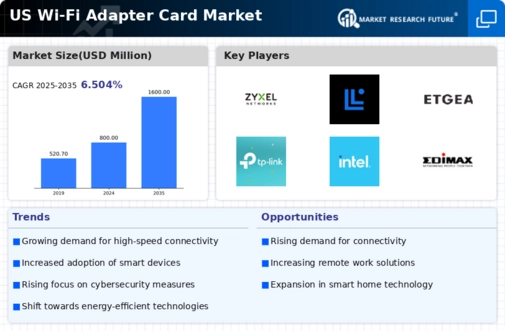Increased Use of IoT Devices
The proliferation of Internet of Things (IoT) devices is a significant driver for the wi fi-adapter-card market. As households and businesses increasingly adopt smart devices, the demand for reliable wi fi connectivity has escalated. Current estimates suggest that there are over 1 billion IoT devices in use across the US, many of which require efficient wi fi-adapter cards to function optimally. This trend is expected to continue, with projections indicating that the number of IoT devices could double in the next few years. The wi fi-adapter-card market must therefore innovate to provide solutions that can handle the increased load and ensure seamless communication between devices, thereby enhancing user experience.
Growing Cybersecurity Concerns
Growing cybersecurity concerns are influencing consumer choices in the wi fi-adapter-card market. As cyber threats become more sophisticated, users are increasingly prioritizing security features in their networking equipment. Recent surveys indicate that over 60% of consumers consider security a critical factor when purchasing wi fi-adapter cards. This trend has prompted manufacturers to enhance the security features of their products, integrating advanced encryption protocols and secure access technologies. The wi fi-adapter-card market is thus adapting to these concerns, focusing on delivering solutions that not only provide connectivity but also protect users from potential cyber threats, thereby fostering consumer trust and loyalty.
Expansion of Remote Work Culture
The expansion of remote work culture has significantly influenced the wi fi-adapter-card market. With a growing number of employees working from home, the demand for reliable and high-performance wi fi-adapter cards has increased. Data indicates that around 30% of the US workforce is now engaged in remote work, leading to a heightened focus on home office setups that require robust internet solutions. This shift has prompted consumers to invest in quality wi fi-adapter cards that can support high bandwidth activities such as video conferencing and large file transfers. Consequently, the wi fi-adapter-card market is poised for growth as it adapts to the needs of a workforce that prioritizes connectivity and efficiency in their home environments.
Rising Demand for High-Speed Internet
The increasing demand for high-speed internet connectivity is a primary driver in the wi fi-adapter-card market. As more consumers and businesses seek faster and more reliable internet access, the need for advanced wi fi-adapter cards has surged. According to recent data, approximately 80% of households in the US now utilize high-speed internet, which necessitates the use of efficient wi fi-adapter cards to support multiple devices simultaneously. This trend is particularly evident in urban areas where internet usage is significantly higher. The wi fi-adapter-card market is thus experiencing a robust growth trajectory, as manufacturers innovate to meet the evolving needs of consumers who require seamless connectivity for streaming, gaming, and remote work.
Technological Advancements in Wireless Communication
Technological advancements in wireless communication are driving innovation within the wi fi-adapter-card market. The introduction of new standards, such as Wi-Fi 6 and the anticipated Wi-Fi 7, offers improved speed, capacity, and efficiency. These advancements are crucial as they enable users to connect more devices without compromising performance. The wi fi-adapter-card market is witnessing a shift towards these next-generation technologies, with manufacturers investing in research and development to create products that leverage these capabilities. As consumers become more aware of the benefits of these technologies, the demand for compatible wi fi-adapter cards is likely to increase, further propelling market growth.























Leave a Comment